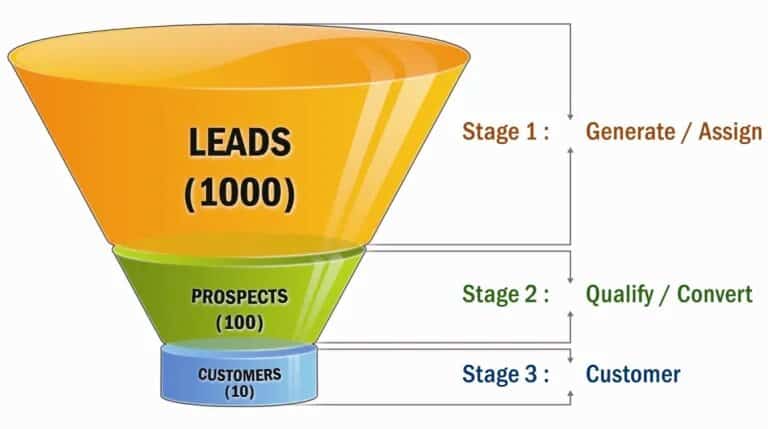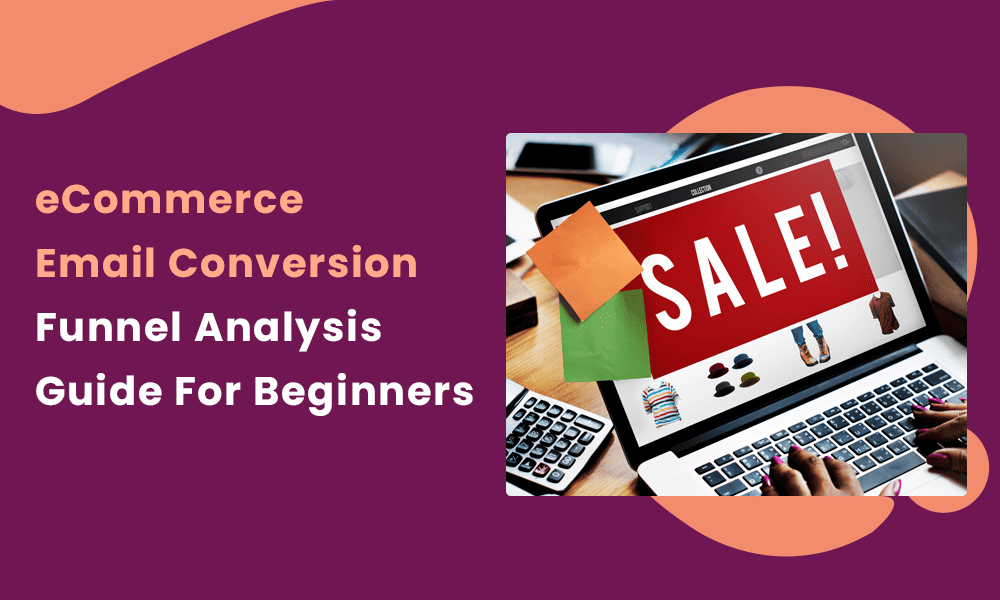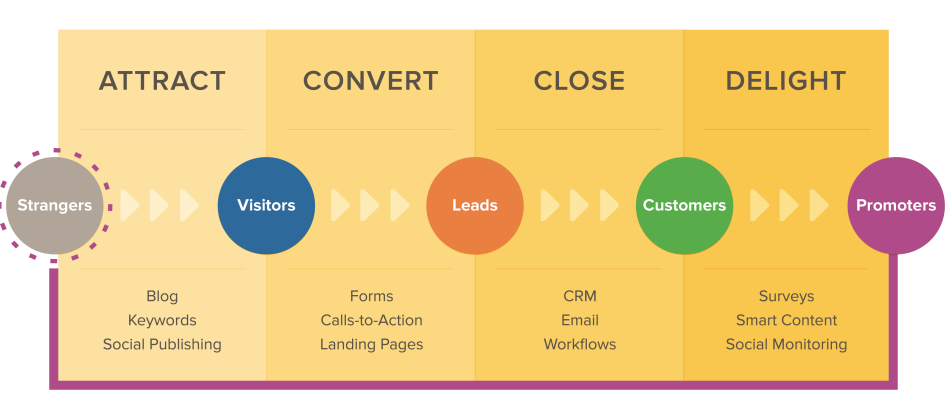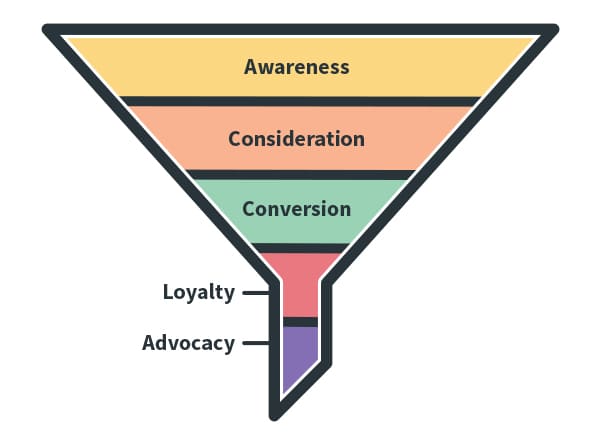For almost as long as eCommerce has existed, conversion analysis has been the heart and soul of tracking and optimizing sales.
eCommerce email conversion funnel analysis helps you, as a business owner, growth marketer, or eCommerce sales manager, track and refine your customers’ purchasing journey through the email marketing funnel to optimize it for better results.
In this blog post, we cover the following:
- eCommerce email conversion funnel analysis
- How the different funnel stages can be optimized for conversion
- How to track your eCommerce email conversions
Table of Contents
What is eCommerce Email Conversion Funnel Analysis?
In eCommerce, email conversion funnel analysis helps you measure how your buyers move across the stages, from the first contact onwards.
A conversion funnel is a marketing term used to describe the different stages in a customer journey from when they get to know about your brand till they take a desired action, i.e., make a purchase. So, it is the different stages a customer goes through, from awareness to taking action.
Funnel analysis, on the other hand, is how you, as the business owner, trace your customer journey and see how customers move from one stage to the other in the conversion funnel.
A funnel analysis enables you to get insights on:
- The number of customers who get to each stage of the funnel
- Where customers drop in the conversion funnel (where you are losing customers)
- The possible bottlenecks causing leads to drop so that the funnel can be better optimized

So, a conversion funnel analysis helps you measure how your leads move across each stage in their customer journey from leads to customers.
Understanding the eCommerce email conversion funnel
To aid our understanding, defining an eCommerce email conversion funnel is necessary before going into the analysis.
An eCommerce email conversion funnel is a series of specially curated emails designed to guide customers through their journeys, from leads or strangers to becoming paying customers and promoters.
This email marketing funnel effectively builds and maintains strong customer relationships through targeted email campaigns across each stage of the funnel for conversion rate optimization.
Email marketing funnels are effective in achieving three main goals:
- Nurture existing leads
- Directing them through the funnel to make sales
- Drive repeat purchases through smart content
You can automate this process by building email workflows on email marketing software like EngageBay.
While this marketing funnel is useful in attracting new customers, it’s double as important to turn prospects into paying customers, paying customers into repeat customers, and repeat customers into promoters by delighting them with your offers and smart messages.
How To Analyze Your eCommerce Email Conversion Funnel
As emphasized earlier, an email marketing conversion funnel enables you to guide your customers from leads to paying customers. It helps you get your customer from stage A to B on the customer journey.
To effectively analyze your eCommerce email conversion funnel, you need to know the different stages involved, from attracting leads to becoming paying customers and possibly advocates for your brand.
1. Awareness
The awareness stage begins the conversion funnel. For people to buy from you, they need to see you, right? So, in this stage, the focus is on getting your brand in front of many potential customers. Target your ideal customers, not just random people, to get the most from this stage.
For example, if you sell items for school children, your chances of getting more qualified leads or prospects are higher if you place ads on blogs for moms compared to sports websites.
There are three main goals in this stage:
- Create more awareness. It could be through social media marketing, content marketing, or Google Ads
- Lead prospects to your landing page or the product page
- Get their email address by offering something valuable; a checklist, an eBook, a workbook, or a bonus pack. The aim is to make prospects willingly give out their email address in anticipation of something valuable.
2. Consideration
The consideration stage is arguably the most delicate in the eCommerce conversion funnel. Here’s why: Some subscribers’ interest drops after receiving what you offered as a lead magnet, so you have to reactivate their interest to make them consider becoming customers.
Another goal in this consideration stage is to focus on registering the brand in the mind of the potential customer and ensuring that they develop trust in your eCommerce brand.
One way you can do this is by investing heavily in educational content. Surveys show that customers are 131% more likely to purchase after they consume educational content.
So, for eCommerce email conversion, this means sending emails that provide value to subscribers and showing them how the product can serve them. To do this, You need to segment your email contacts based on customer demographics and understand their pain points, so you can send targeted content that resonates.
You’d want to keep your emails engaging and make your subscribers look forward to each mail. Failure to do so would lead to a drop in open rates, potentially reducing the percentage of leads who make it to the next stage: the conversion stage.
Read also: eCommerce Product Recommendation Emails You’ll Love
3. Conversion
This is the stage where a lead is ready to take action. Your goal here is to convert your leads into paying customers. Drive this stage by including:
- Appealing product images
- Videos of products
- Testimonials from clients who have used your products
- CTAs like “Buy now,” “Get started,” and “Try it out now.”
At this stage, be generous with incentives such as discounts and shipping discounts.
4. Loyalty and retention
Your work isn’t done yet after a customer purchases. You must keep nurturing existing customers to drive repeat purchases and increase customer retention rates.
This is important because existing customers are 60-70% more likely to purchase than potential customers. So, at this stage, you communicate with customers to nurture them into becoming brand advocates and loyal customers. You also engage them actively to improve their experience and build loyalty.
Here is a good place to introduce loyalty programs. Additionally, ask for customer feedback to see areas you need to improve.
5. Advocacy
The goal here is to get a pool of loyal customers who will evangelize your product. One way to know if you have a pool of happy customers willing to do word-of-mouth marketing for your product is by conducting a Net Promoters Score (NPS) survey.
Net Promoter Score is a data-driven evaluation of customer satisfaction based on how likely they are to recommend your product or services to others on a scale between 0 (the most negative) and 10 (the most positive).
Read also: eCommerce Sales Funnels 101: A Beginner’s Guide
eCommerce Email Conversion Funnel Metrics That Matter The Most
To analyze your eCommerce email conversion funnel, we need to look at the following metrics of each email campaign:
- Number of emails delivered
- Unique open rate
- Number of unique clicks
- Rate of email conversion
Number of emails delivered
It is important to note that only some emails sent get delivered. Some emails bounce for several reasons, such as an invalid email address or a full mailbox on the recipient’s end.
To explain further, let’s say Brand X sends an email campaign to 2,000 subscribers, of which 1,900 get delivered and 100 bounce. Brand X’s email delivery rate is 95%. Here’s the formula:
Number of emails delivered divided by the number of emails sent multiplied by 100 (No. of emails delivered / No. of emails sent x 100)
Number of unique opens
Next is to track the number of unique opens. It’s important to know that unique opens differ from total opens. For instance, if a subscriber opens an email ten times, it counts as just one unique open.
Continuing our illustration above, out of the 1,900 subscribers who received brand X’s emails, if only 700 opened the email, the email open rate can be calculated using the formula:
No. of unique opens ÷ No. of delivered email x 100
It means that Brand X’s email open rate is 700/1,900 x 100 = 36%
Alternatively, you can track your email campaign open rates using Google Analytics or the data report from your email marketing software.
Number of unique clicks
The next stage in this eCommerce sales funnel analysis is where we track the number of unique click-throughs.
Continuing with our illustration, out of the 1,900 unique opens, if 300 subscribers clicked on the CTA link, the CTR for brand X’s email campaign would be calculated with the formula:
Total clicks/No. of opens x 100
Therefore, the number of unique clicks for Brand X will be 300/1,900 x 100 = 15.7%
Rate of email conversion
To calculate this, divide the number of people who purchased by the number of delivered emails and multiply it by 100.
So, if 75 eCommerce email subscribers make a purchase, the brand X’s eCommerce email conversion rate will be calculated thus:
75/1,900 x 100 = 3.9%
On average, the eCommerce email conversion rate is 2.2% for B2C consumers, so Brand X’s conversion rate of 3.9% is good.
When analyzing your eCommerce email conversion funnel, you need to observe the points with a drastic drop-off and find ways to optimize them.
For instance, if there’s a significant drop-off from the click-through rate to the conversion rate, it could be that the checkout process needs to be shorter or the shipping fee needs to be lowered so prospects can make a purchase.
Conversely, some factors could be responsible if there’s a high drop-off between the open and click-through rates, such as email content not resonating with subscribers.
Additionally, carry out heatmap analysis on your eCommerce email to see the hottest spots and the coolest points in your email campaign.
Read also: eCommerce Conversion Funnel in 5 Stages
How To Optimize the Email Conversion Funnels for eCommerce
Optimizing your email eCommerce sales funnel ensures that you constantly change your eCommerce conversion strategy to be more effective at driving sales. Here are some ways to optimize your email funnel.
1. Curate different email content for different stages
A significant part of the conversion strategy for the eCommerce sales funnel is curating different types of emails for the different customer stages.
This strategy ensures that you take subscribers through all the stages of the funnel such that every stage is nurtured appropriately with targeted content.
With marketing automation, you can easily segment customers and send personalized messages at scale. Additionally, you can increase communication touchpoints across multiple platforms to keep you in prospects’ minds when they decide to purchase.
An excellent step to take when curating content for the different stages is first to put yourself in the position of your target audience. You can start by asking questions like:
- What would I want?
- How can this business help me solve my needs or wants?
- What sort of emails do I expect to get from them?
- Is the communication clear and enticing enough to prompt me to purchase?
- Is this offer irresistible?
In answering these questions, you come closest to satisfying your target audience and boosting the efficiency of your conversion funnel.
2. Plan the email content in line with business priorities and needs
Every business has a major goal they wish to attain with their email campaigns.
For instance, an eCommerce brand that is new and looking first to build a subscriber base will have a much different strategy from another with an established subscriber base, looking to build loyalty from existing customers and increase the retention rate.
While the former will focus more on building customer trust, the latter will focus on optimizing the eCommerce conversion rate.
Read also: Marketing Automation Funnel Explained For Beginners
3. Be definitive with the intention and call-to-action
The endpoint of a conversion funnel is to drive sales.
While you may focus on getting the customers acquainted with the business initially, it’s best to build a clear pathway leading to a CTA in the subsequent emails.
Additionally, personalize CTAs based on customers’ behaviors, demographics, or preferences. A HubSpot report revealed that personalized CTAs perform 202% better than generic CTAs.
4. Target passive subscribers with re-engagement emails
While taking your subscribers through the different funnel stages, some will fall off.
Devise a means to get them back on the funnel. You can decide to offer discounts or send win-back email campaigns. Additionally, send out a survey to know why they stopped engaging with your emails.
At this stage, your goal is to get as many subscribers as possible back to the email conversion funnel.
5. Leverage survey emails to understand customer preferences
Focusing on customer preferences to optimize the funnel helps you understand the reason behind their decisions at different levels. It gives insight into how to help them move further down the funnel.
For instance, if you observe subscribers unsubscribing from the email list at the awareness stage, then focus on curating more appealing content to the target audience so that they are compelled to stay subscribed.
Conversely, if your ultimate goal is to lead customers through all the funnel stages to make a purchase, then focus your strategy on easing the process through the funnel stages.
Read also: A Beginner’s Guide to Lead Funnels: How to 2X Your Sales
Conclusion
A conversion funnel analysis is key to identifying the bottlenecks in your eCommerce email marketing strategy so that you can refine and optimize it for better results.
To get the best out of your eCommerce email marketing conversion funnel, eliminate repetitive tasks by automating your email workflow on a sophisticated email platform like EngageBay.
Want to optimize your eCommerce email efforts even better? Streamline your sales and marketing efforts on a single platform. To get started, sign up for free today.




The blog is a must-read for anyone venturing into the world of ecommerce marketing. The author has done a commendable job in providing a comprehensive analysis of email conversion funnels, making it an invaluable resource for beginners in the field.
For more marketing ideas and strategies, I would highly recommend visiting our website – https://www.biteblueprint.com